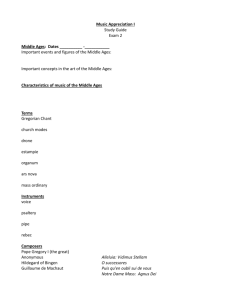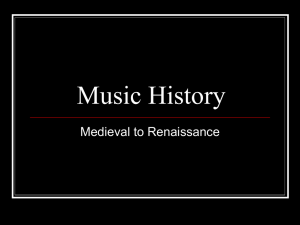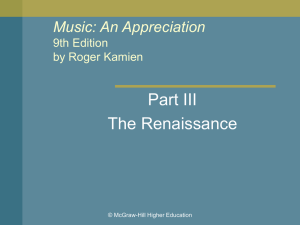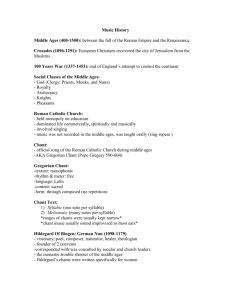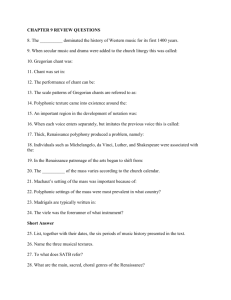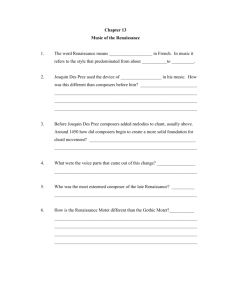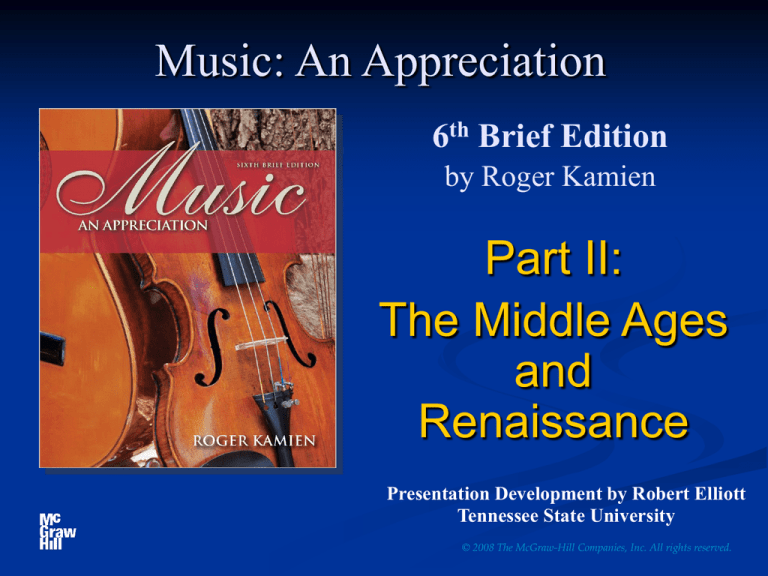
Music: An Appreciation
6th Brief Edition
by Roger Kamien
Part II:
The Middle Ages
and
Renaissance
Presentation Development by Robert Elliott
Tennessee State University
© 2008 The McGraw-Hill Companies, Inc. All rights reserved.
Time Line
Middle Ages (450-1450)
Rome sacked by Vandals
455
Beowolf
c. 700
First Crusade
1066
Black Death
1347-52
Joan of Arc executed by English
1431
Part II – The Middle Ages and Renaissance
Time Line
Renaissance (1450-1600)
Guttenberg Bible
1456
Columbus reaches America
1492
Leonardo da Vinci: Mona Lisa
c. 1503
Michelangelo: David
1504
Raphael: School of Athens
1505
Martin Luther’s 95 Theses
1517
Shakespeare: Romeo and Juliet
1596
Part II – The Middle Ages and Renaissance
The Middle Ages
Period of wars and mass migration
Strong class distinctions
– Nobility: castles, knights in armor, feasting
– Peasantry: lived in huts; serfs—part of land
– Clergy: ruled everyone; only monks literate
Part II – The Middle Ages and Renaissance
The Middle Ages
Architecture
– Early: Romanesque
– Late: Gothic
Visual Arts
– Stressed iconic/symbolic, not realism
Late Middle Ages saw technological progress
Part II – The Middle Ages and Renaissance
The Renaissance
Rebirth of human learning and creativity
Time of great explorers
Humanism
Fascination with ancient Greece and Rome
Part II – The Middle Ages and Renaissance
The Renaissance
Visual art becomes more realistic
– Mythology is favorite subject
– Nude body, as in ancient times, is shown
Weakening of the Catholic Church
Education and literacy now status
symbol
– Result of invention of printing press
David by Michelangelo
Part II – The Middle Ages and Renaissance
Chapter 1:
Music in the Middle Ages
Church dominates musical activity
– Most musicians were priests
– Women did not sing in mixed church settings
Music primarily vocal and sacred
– Instruments not used in church
Chapter 1
Gregorian Chant
Was official music of Roman Catholic Church
– No longer common since Second Vatican Council
Monophonic melody set to Latin text
Flexible rhythm without meter and beat
Named for Pope Gregory I (r. 590-604)
Originally no music notation system
– Notation developed over several centuries
The Church Modes
“Otherworldly” sound—basis of Gregorian Chant
Different ½ and whole steps than modern scales
Middle Ages and Renaissance used these scales
– Some Western Music uses these scale patterns
- What Do You Do With a Drunken Sailor?—Dorian mode
- When Johnny Comes Marching Home—Aeolian mode
Chapter 1
Listening
Alleluia: Vidimus stellam
(We Have Seen His Star)
Listening Outline: p. 68
Brief set, CD 1:47
Listen for: Gregorian Chant (Latin language)
Many notes per syllable of text
Monophonic texture
Ternary form—A B A
Chapter 1
Listening
O Successores (You Successors)
Hildegard of Bingen
Listening Guide: p. 70
Brief Set, CD 1:50
Chant
Originally written without accompaniment
This recording includes a drone—long, sustained notes
Note extended range of melody
Written for nuns by a nun (to be sung in convent)
Chapter 1
Secular Music in the Middle Ages
Troubadours (southern France) and Trouveres
(northern France)
– Nobles wrote poems/songs for court use
- Performed by jongleurs (minstrels)
– Topics: courtly love, Crusades, dancing
Chapter 1
Estampie
Medieval (Middle Ages) dance music
Triple meter with strong beat (for dancing)
– Notated as chant: only a single melody line
- Performers probably improvised accompaniment
Listening example—Brief Set, CD 1:51
– This performance played on period instruments
- Melody played on rebec (bowed string instrument and pipe
(tubular wind instrument)
- Drone on psaltery (plucked or struck string instrument)
Chapter 1
The Development of Polyphony:
Organum
Between 700-900 a second line added to chant
– Additional part initially improvised, not written
– Paralleled chant line at a different pitch
900-1200 added line grew more independent
– Contrary motion, then later a separate melodic curve
– c. 1100 note-against-note motion abandoned
- 2 lines with individual rhythmic and melodic content
- New part, in top voice, moved faster than the chant line
Chapter 1
School of Notre Dame: Measured Rhythm
Parisian composers developed a rhythmic notation
– Chant notation had only indicated pitch, not rhythm
– Notre Dame’s choirmasters Leonin and Perotin were leaders
- Writing with notated rhythm came to be called the Notre Dame style
Medieval thought was that
interval of third dissonant
– Modern chords built of
thirds are now considered
consonant
Notre Dame Cathedral
Chapter 1
14th-Century Music: “New Art” In France
Composers wrote music not based on chant
– Borrowed secular melodies to put in sacred music
New music notation system had developed
– New system allowed for better rhythmic notation
– Syncopation, now possible, became common
The new type of music was called ars nova
Chapter 1
Guillaume de Machaut
Mid- to late-14th-century composer (1300-1377)
– Also famous as a poet
– Though a priest, spent most of life working at court
Wrote both sacred and secular music
Best known for his Notre Dame Mass
Listening
Puis qu’en oubli sui de vous
(Since I am forgotten by you; around 1363)
by Guillaume de Machaut
Vocal Music Guide: p. 75
Brief Set, CD 1:52
Listen for:
Melancholy feel
Rondeau form (8 lines, ab aa ab ab,)
Syncopation
Interpretation (3 notated lines, 1 text)
Chapter 1
Listening
Agnus Dei from Notre Dame Mass
by Guillaume de Machaut
Vocal Music Guide: p. 79
Brief Set, CD 1:53
Performance Profile:
Andrew Parrott-conductor
Listen for conductor’s
interpretation, use of solo
voices, and attempt to
create an historically
accurate performance
14th century, part of mass ordinary
Polyphonic—4 voices (parts)
Ternary form: A B A (form results from the text)
Agnus Dei, qui tollis peccata mundi: miserere nobis
Agnus Dei, qui tollis peccata mundi: miserere nobis
Agnus Dei, qui tollis peccata mundi: dona nobis pacem
Chapter 1
Chapter 2:
Music in the Renaissance
Church choirs grew in size (all male)
Rise of the individual patron
– Musical center shifted from church to courts
– Court composers wrote secular and sacred music
– Women did not sing in mixed church settings
Chapter 2
Musicians: higher status and pay than before
– Composers became known for their work
Many composers were Franco-Flemish
– Worked throughout Europe, especially in Italy
Italy became music capital in 16th century
– Other important centers: Germany, England, Spain
Chapter 2
Characteristics of Renaissance Music
Words and Music
Vocal music more important than instrumental
Word painting/text painting
Chapter 2
Texture
Polyphonic
Primarily vocal - a cappella
– Instruments, if present, doubled the vocal parts
Rhythm and Melody
Rhythm “flows” and overlaps
– Composers less concerned with metrical accents
Smooth, stepwise melodies predominate
– Melodies overlap rhythmically between voices
Chapter 2
Sacred Music in the Renaissance
Two main forms:
Motet
– Short polyphonic choral work
– Latin text usually overlaid with vernacular text
– Often borrows lowest voice part from a chant
Mass—the Catholic worship service
– Long work that includes five main parts of service
-
Kyrie
-
Sanctus
-
Gloria
-
Agnus Dei
-
Credo
Chapter 2
Josquin Desprez
1440-1521 (contemporary of Columbus & da Vinci)
Wrote both sacred and secular music
– Worked with the Papal Choir in Rome
– Worked for King Louis XII of France
Leading composer of his time; famous while alive
– His work influenced other composers
– Was highly praised by Martin Luther
Chapter 2
Listening
Ave Maria…Virgo Serena
Josquin Desprez
Vocal Music Guide: p. 82
Brief Set, CD 1:56
Listen for: Four voices
Polyphonic imitation
Overlapping voice parts
Chapter 2
Palestrina
Culmination of the Renaissance (1525-1594)
Worked primarily in Rome
– Music director at St. Peter’s
Worked during and after Council of Trent
– Council of Trent (1545-1563) addressed:
- Abuses and malpractice within church
- Emerging Protestantism
- Role of music in worship
- Some advocated a return to monophonic music
- Finally decided on non-theatrical worship music
Wrote music meeting demands of Trent
– His work became the model for mass composers
Chapter 2
Listening
Pope Marcellus Mass (1562-63)
Kyrie
by Palestrina
Vocal Music Guide: p. 85
Brief Set, CD 1:59
Six voices
Polyphonic imitation w/ overlapping voice parts
Text:
Kyrie eleison
Christe eleison
Kyrie eleison
Chapter 2
Secular Music in the Renaissance
Madrigal
– Intended for amateur performers (after dinner music)
– Extensive use of text painting
– Printed in part-book or
opposing-sheet format
– Originated in Italy
- English madrigal
lighter and simpler
Chapter 2
Listening
As Vesta was Descending (1601)
by Thomas Weelkes
Vocal Music Guide: p. 87
Brief Set, CD 1:62
Follow text (English) throughout song
Note text painting:
Pitches rise on “ascending”
Pitches fall on “descending”
“Running down”
“Two by two,” “three by three,” “all alone”
Chapter 2
Instrumental Music
Still subordinate to vocal music
– Increasingly, instruments accompanied voices
– Sometimes played adapted vocal music alone
Published music stated that various parts of the
music could be sung or played
Chapter 2
Purely instrumental music existed almost
exclusively for dancing
– Dancing became ever more popular during the
Renaissance
Distinction between loud outdoor instruments and
softer indoor ones
Composers did not specify instrumentation
Chapter 2
Listening
Passamezzo and Galliard
by Pierre Francisque Caroubel
From Terpsichore (1612) by Michael Praetorius
Listening Guide: p. 91
Basic Set, CD 1:81
Renaissance dance music
Dances frequently played in pairs
Passamezzo in duple meter (form: a a’ b b’ c c’)
Galliard in triple meter (form: a a’ b b’ c c’ a’ b’ c’)
Instrumentation not specified in written music
Chapter 2

